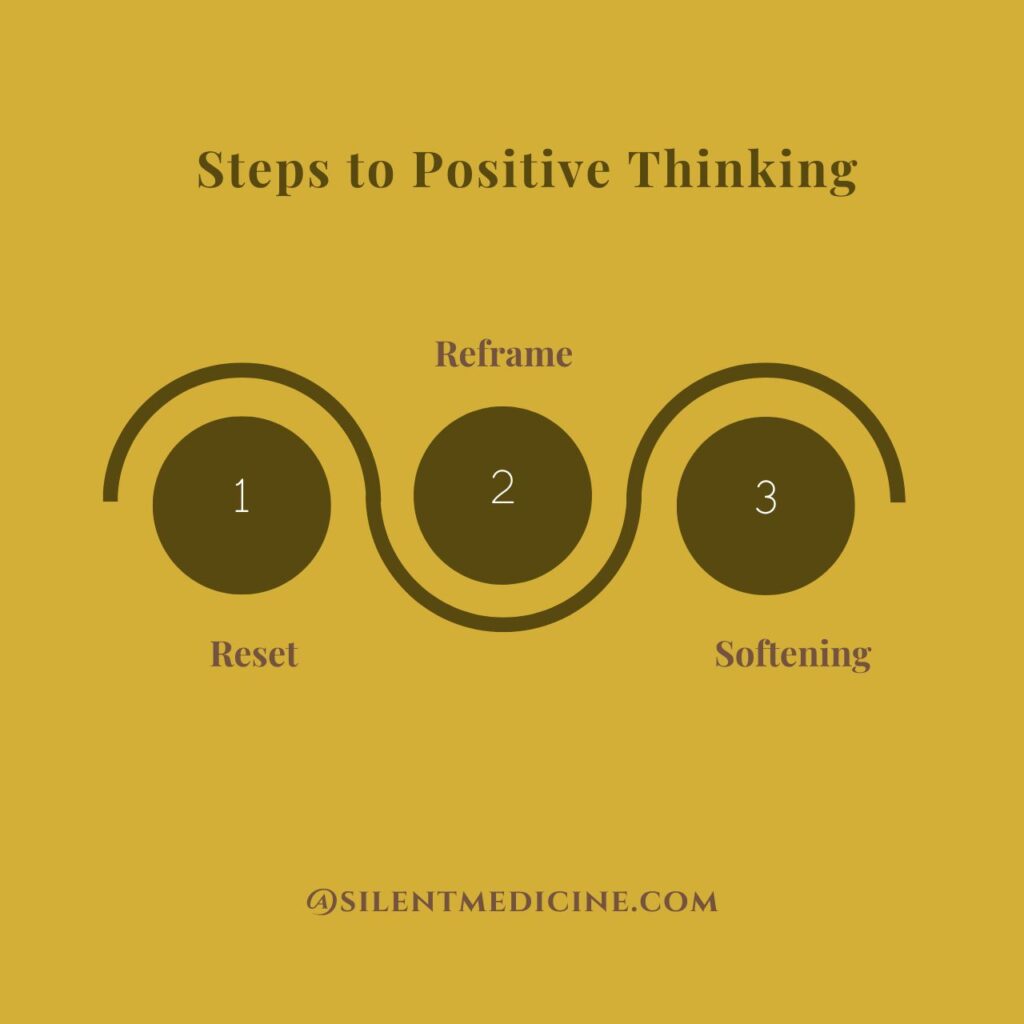What are the health benefits of positive thinking?
Quick Answer
“Positive thinking” here means realistic optimism… meeting reality as it is, then choosing the most helpful next step. It’s not pretending everything is fine; it’s how you talk to yourself, how you interpret events, and whether you keep looking for workable options. Practiced consistently, this mindset may support steadier stress responses, more resilient habits, and kinder choices… small changes that can add up over time.

What “positive thinking” really means (and what it isn’t)
- Realistic, not Pollyanna. You see facts clearly and still look for leverage points.
- Self-talk aware. You notice harsh inner commentary and shift to language that’s accurate and helpful.
- Possibility-seeking. Even in constraints, you keep scanning for one doable action.
- Not toxic positivity. You don’t bypass grief, anger, or complexity. Emotions are data… you let them move.
How it may influence your body (indirectly)
While thoughts don’t flip a magic switch, your interpretations can influence day-to-day behaviors that affect well-being such as breathing, tension patterns, sleep routines, food pace and choices, as well as social connection. Over time, these small choices may support steadier nervous-system tone and coping.
Safety note: if you’re struggling with depression, anxiety, or trauma, please connect with a qualified clinician. Mindset tools are not a substitute for care.
Five tiny skills to practice
- Name the moment. “This is hard, but I can take one small step.”
- Swap always/never. Replace absolutes with specifics: “This project ran late today; I can start earlier tomorrow.”
- Micro-choice framing. Ask, “What’s one helpful thing I can do in the next 10 minutes?”
- Kind inner tone. Speak to yourself like you would to a dear friend.
- Possibility note. Write one alternative you hadn’t considered yet.
2-minute practice: Reset + Reframe
- Unclench jaw and shoulders; exhale slowly.
- Breathe 4/6 (inhale 4, hold 2, exhale 6) for 3 cycles; feel your feet.
- Write one sentence: “What happened, what I can do, what I’ll try next.”
- Act on that one small step.
(Try it before meals with this mindful-bite practice →)
Read: Mindful Eating — first bite →
Reflections
1-Minute Reflections
- Where did my self-talk tilt helpful vs. harsh today?
- What single thought helped me take a small, useful action?
- One place my body whispered “enough.” What changed when I listened?
- If I rewrite one sticky thought in kinder, accurate language, what does it become?
- What’s one tiny step I can take in the next 10 minutes?
1-Minute Reflections: Where did my self-talk tilt helpful vs. harsh today? Write one kinder, accurate rewrite. (No need to send… just practice.)
Potential benefits people report (may support you as well)
Framed as possibilities… not promises:
- Lower perceived stress and steadier coping day to day
- Better problem-solving and flexible thinking under pressure
- More consistent self-care (sleep routines, movement, gentler food pace)
- Greater resilience after setbacks; less rumination
- Social ease (clearer requests, healthier boundaries)
(Research often links optimism with markers like stress reactivity and health behaviors, but individual experiences vary.)
Watch-outs (where positivity can backfire)
- Bypassing feelings. All emotions are allowed; I see emotions as visitors and preserving signals… useful information, not instructions.
- Blame & shame. If you “fail,” switch to curious next step vs. self-attack, or condemnation.
- Comparison loops. Use others’ wins as data or inspiration, not proof you’re behind.
Note: Emotions aren’t instructions; they’re information. Let them visit, learn what they protect, then decide your next helpful action.
Research Corner
Research often links optimism with markers like stress reactivity and health behaviors
FAQ
Is “positive thinking” the same as ignoring problems?
No. It’s acknowledging reality and choosing a helpful response.
Can positive thinking cure illness?
No. It can support habits and coping. For any medical concern, see your clinician.
What if my self-talk is really harsh?
Start with tone. Write your thought, then rewrite it as if speaking to a friend. Practice daily.
How long until I notice changes?
Some people feel a small shift the same day (less tension, clearer next step). Durable change comes from repetition.
What if everything feels heavy right now?
Begin with the 2-minute practice above and a single micro-win per day. If symptoms persist or worsen, get professional support.
Related reading
Get book updates: we’ll share simple practices & excerpts:
Clinical services are provided within my scope as a licensed clinical psychologist (CA, RI). My Doctor of Integrative Medicine credential is a doctoral degree with board certification by the Board of Integrative Medicine (BOIM) and does not represent a medical/physician license. All educational content is for learning only and is not a substitute for professional medical or psychological care.
About Dr. Nnenna Ndika
Dr. Nnenna Ndika is an integrative, trauma-informed clinical psychologist (CA/RI) and Doctor of Integrative Medicine (BOIM). Her work bridges neuroscience, somatic regulation, and environmental rhythms—simple, minimalist practices that help the body remember safety and the mind regain quiet strength. Silent Medicine is educational only; it does not replace medical or psychological care. Begin with Start Here or explore Mind-Body Healing.






